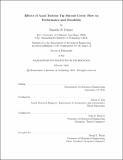Effects of axial turbine tip shroud cavity flow on performance and durability
Author(s)
Palmer, Timothy R. (Timothy Richard)
DownloadFull printable version (20.99Mb)
Other Contributors
Massachusetts Institute of Technology. Department of Mechanical Engineering.
Advisor
Choon S. Tan.
Terms of use
Metadata
Show full item recordAbstract
Flow through tip shroud cavity in a representative axial turbine vane-rotor stage environment is assessed for its role in loss generation and turbine durability. Steady and unsteady three-dimensional flow computations, complemented by control volume analyses, for varying shroud configurations provided results for establishing quantitative links between loss and ow processes as well as loss level scalings. Specifically tip shroud cavity flow is dominated by two counter-rotating vortices upstream, and a free expansion leakage jet downstream, of the tip seal, followed by a mixing shear layer at cavity exit. One of the vortices, the cavity inlet toroidal vortex, sets the loss level within the cavity inlet and the mass ow recirculated out of the cavity into the main flow path. It is found that tip shroud cavity flow incurs a 0:85% debit in stage eciency per 1% of main flow fluid through the cavity with approximately 50% generated in the free expansion of the tip seal leakage jet and 50% from cavity exit mixing. The proportion of total loss attributable to cavity exit mixing increases with tip seal gap. In addition, vane-rotor unsteady interaction induces an additional 0:25% debit in eciency per 1% of main flow fluid through the cavity. The additional efficiency penalty induced by vane-rotor unsteady interaction results from an enhancement of the cavity inlet toroidal vortex and associated recirculated mass flow. Overall cavity loss is set by cavity mass flow fraction, stagnation pressure ratio across tip seal, velocity disparity between cavity exit flow and rotor exit flow, and cavity inlet vortex strength. These findings were used to formulate a modified tip shroud configuration that nearly eliminates cavity exit mixing loss, but it incurs a penalty associated with cavity flow low Reynolds number effects and induced mismatching between vane and modified tip shroud. In the process of designing this modified tip shroud, it was found that the turbine main flow perceives the cavity as a line sink-source pair, permitting estimation of flow redistribution in the main flow path. Finally, any operational transients which eliminate tip seal clearance would lead to enhanced impingement heat transfer at blade tip due to recirculating ow from cavity inlet; this can increase the likelihood of blade failure.
Description
Thesis: Ph. D., Massachusetts Institute of Technology, Department of Mechanical Engineering, 2015. This electronic version was submitted by the student author. The certified thesis is available in the Institute Archives and Special Collections. Cataloged from student-submitted PDF version of thesis. Includes bibliographical references (pages 225-228).
Date issued
2015Department
Massachusetts Institute of Technology. Department of Mechanical EngineeringPublisher
Massachusetts Institute of Technology
Keywords
Mechanical Engineering.